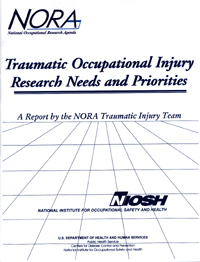Traumatic Occupational Injury Research Needs and Priorities
June 1998
DHHS (NIOSH) Publication Number 98-134

A Report by the NORA Traumatic Injury Team
The National Institute for Occupational Safety and Health (NIOSH), and its partners in the public and private sectors, have developed the National Occupational Research Agenda (NORA) to provide a framework to guide occupational safety and health research through the next decade—not only for NIOSH but for the entire occupational safety and health community.1 Approximately 500 organizations and individuals outside NIOSH provided input into the development of the Agenda. This effort to guide and coordinate research at a national level addresses those topics that are most likely to benefit the worker and the Nation. Fiscal constraints on occupational safety and health research reinforce the need for a coordinated and focused national research agenda.
Partnership teams are a key part of implementing NORA.2 Twenty partnership teams have been formed to address the priority areas, including one focused on traumatic occupational injury. These teams are assisting in the development, pursuit, implementation, review, and dissemination of research under each NORA topic. The Traumatic Injury Team has compiled this report in an effort to describe the research needed to advance the knowledge, and thus the prevention, of traumatic occupational injuries. The team welcomes the input and assistance of occupational safety and health professionals and representatives of management, labor, professional societies, academia, and others in accomplishing these tasks.
This document is not intended as a definitive or detailed listing of all necessary research tasks in occupational injury research. Rather, the intent is to present a broad framework of the objectives and research needed to begin filling the gaps in knowledge and furthering progress toward safer workplaces and practices. We hope that the objectives and research framed by this document will be used by a wide variety of organizations as a basis for planning and prioritizing research and collaborative efforts. Government agencies, academic institutes, public and private research organizations, labor organizations, professional societies, and others might use this document to assist in focusing their own research activities, and as a basis for pursuing new partnerships and identifying topics for collaborative efforts. The greatest potential for progress in preventing occupational traumatic injuries will be realized when the many agencies and organizations with interest and expertise in this area coordinate their research efforts and pool their resources and expertise in collaborative research projects. This document provides a reference and structure for traumatic occupational injury research that can be used to facilitate the initiation of new, and the rekindling of existing, partnerships and collaborative research to prevent worker injuries and deaths.
Traumatic Occupational Injury Research Needs and Priorities [PDF - 193 KB]
- Page last reviewed: June 6, 2014
- Page last updated: June 6, 2014
- Content source:
- National Institute for Occupational Safety and Health Education and Information Division


 ShareCompartir
ShareCompartir